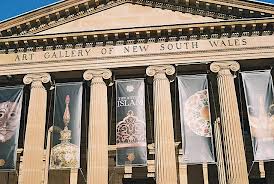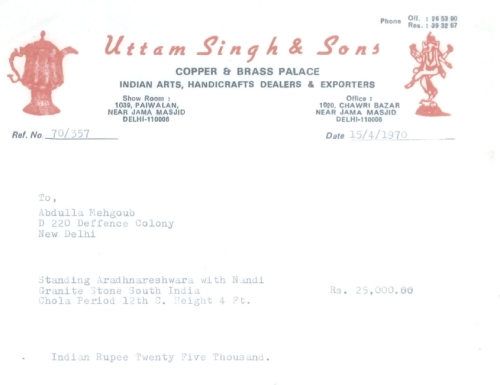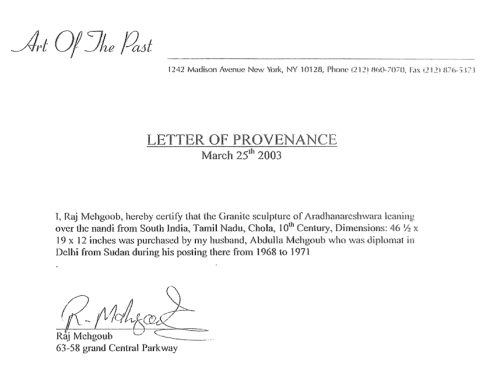 The Art Gallery of New South Wales has released provenance information for one of the six objects it purchased from Subhash Kapoor, the New York antiquities dealer currently facing trial in India for trafficking in looted art. (Past coverage here.)
The Art Gallery of New South Wales has released provenance information for one of the six objects it purchased from Subhash Kapoor, the New York antiquities dealer currently facing trial in India for trafficking in looted art. (Past coverage here.)
UPDATE 8/18/14: Indian authorities have concluded the Ardhanarishvara sculpture described below was stolen from the Vridhdhagiriswarar Temple in Tamil Nadu India in 2002. The thieves have not been identified, but two years later Kapoor sold the sculpture to AGNSW for $400,000 with a false ownership history.
The release comes in the wake of our revelations about looted objects at the National Gallery of Australia, which acquired 21 objects from Kapoor, including a $5 million sculpture of Shiva that was stolen from an Indian temple not long before it was offered to the museum with bogus ownership history. The NGA has refused multiple requests to release provenance information on any of the objects in its collection, despite compelling evidence several of those objects were looted.
We made similar requests to Sydney’s Art Gallery of New South Wales, which has acknowledged acquiring six objects from Kapoor between 1994 and 2004. Last week, the museum posted information about the Kapoor objects on the provenance research section of its website, which had previously been dedicated to European paintings. After consulting with his board, museum director Michael Brand released on Tuesday the ownership history provided by Kapoor for one of those objects.

Ardhanarishvara
In 2004, the Gallery purchased this Chola-period sculpture from Kapoor for more than $300,000. The 44-inch stone figure represents Ardhanarishvara, the androgynous form of Shiva and Parvati. It comes from Tamil Nadu, home to some 2500 important temples to Shiva. The image of Ardhanarishvara was likely in a niche on an external wall.
Kapoor provided two documents with the sculpture.
One is a receipt dated 1970, purportedly from Uttam Singh and Sons, the Delhi “copper and brass palace” that sold the sculpture to a private collector.

The second document purports to be a 2003 “Letter of Provenance” on letterhead from Art of the Past, Kapoor’s Madison Ave. gallery. It is signed by “Raj Mehgoub,” who claims to be the wife of a diplomat who lived in Delhi from 1968 to 1971.

It is unclear whether the documents are genuine. Uttam Singh and Sons appears to be a real business in Delhi, but we could not reach the owners and did not find record of a Raj or Abdulla Mehgoub.
The documents bear a striking resemblance to other ownership records provided by Kapoor that appear to have been falsified. See, for example, this receipt from a Calcutta gallery for a pair of statues that photos show were in India recently:

The Art Gallery of New South Wales acknowledges it did not obtain provenance information for the other five objects acquired from Kapoor, whose total value was about $100,000. The museum says it has not yet been contacted by Indian or American authorities investigating Kapoor.

Despite lapses in the past, the Gallery should be congratulated for its transparent approach in the current case. Clearly Michael Brand learned from his experience at the Getty Museum, where — as we recount in Chasing Aphrodite — his predecessors’ stonewalling of Italian investigators prolonged the Getty’s troubles for years.
Other museums should follow the Gallery’s lead and use their provenance websites to publish all relevant information about antiquities obtained from Kapoor.


Pingback: Lost and Found: Images Show Art Gallery NSW’s Sculpture Was Stolen From An Indian Temple | CHASING APHRODITE
Pingback: Guilty Plea: Kapoor’s Gallery Manager Cops to Six Criminal Counts | CHASING APHRODITE
Pingback: False Provenance: Indictment of Kapoor’s Girlfriend Reveals Fake Ownership Histories | CHASING APHRODITE
Pingback: Shiva Goes Home: Australia’s Prime Minister Returns Looted Kapoor Idols to India | CHASING APHRODITE
Pingback: The End of the Beginning: NGA Returns Kushan Buddha and Two Kapoor Objects | CHASING APHRODITE